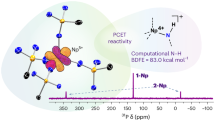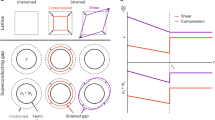Abstract
VALUES are now available for ΔH1, the heat content change in the reaction  where Ln represents a lanthanide element and Y a complexing agent such as the ethylenediaminetetraacetate (EDTA) or nitrilo-triacetate (NTA) ion. The measurements usually refer to dilute solutions of molar concentrations of ∼ 0.01 or less. The dependence of ΔH1 on the atomic number of the lanthanide is often rather complicated, a plot of one quantity against the other showing both a maximum and a minimum. This is true, for example, of the EDTA1 and 1:1 NTA complexes2,3 and the 1:1 and 1:2 diglycollate and dipicolinate complexes4. There are, however, grounds for believing that a complicating factor may be a change somewhere in the middle of the series in the effective hydration number of the uncomplexed lanthanide ion, consequent on the lanthanide contraction. This factor can be eliminated by measuring the integral heats of solution of a series of isomorphous lanthanide salts to give suitably dilute solutions. Such series of salts covering all the lanthanides are not numerous, but two well known ones are the bromates and the ethylsulphates, both of which crystallize as enneahydrates. If, for example, ΔH2 is measured for the process
where Ln represents a lanthanide element and Y a complexing agent such as the ethylenediaminetetraacetate (EDTA) or nitrilo-triacetate (NTA) ion. The measurements usually refer to dilute solutions of molar concentrations of ∼ 0.01 or less. The dependence of ΔH1 on the atomic number of the lanthanide is often rather complicated, a plot of one quantity against the other showing both a maximum and a minimum. This is true, for example, of the EDTA1 and 1:1 NTA complexes2,3 and the 1:1 and 1:2 diglycollate and dipicolinate complexes4. There are, however, grounds for believing that a complicating factor may be a change somewhere in the middle of the series in the effective hydration number of the uncomplexed lanthanide ion, consequent on the lanthanide contraction. This factor can be eliminated by measuring the integral heats of solution of a series of isomorphous lanthanide salts to give suitably dilute solutions. Such series of salts covering all the lanthanides are not numerous, but two well known ones are the bromates and the ethylsulphates, both of which crystallize as enneahydrates. If, for example, ΔH2 is measured for the process  then ΔH1 + ΔH2 = ΔH3, where ΔH3, is the heat content increase for the process
then ΔH1 + ΔH2 = ΔH3, where ΔH3, is the heat content increase for the process  from which the simple hydrated lanthanide ion has been eliminated.
from which the simple hydrated lanthanide ion has been eliminated.
This is a preview of subscription content, access via your institution
Access options
Subscribe to this journal
Receive 51 print issues and online access
$199.00 per year
only $3.90 per issue
Buy this article
- Purchase on Springer Link
- Instant access to full article PDF
Prices may be subject to local taxes which are calculated during checkout
Similar content being viewed by others
References
Mackey, J. L., Powell, J. E., and Spedding, F. H., J. Amer. Chem. Soc., 84, 2047 (1962).
Edelin de la Praudiere, P. L., and Staveley, L. A. K., J. Inorg. Nucl. Chem., 26, 1713 (1964).
Moeller, T., and Ferrus, R., Inorg. Chem., 1, 49 (1962).
Grenthe, I., Acta Chem. Scand., 17, 2487 (1963).
Hoard, J. L., Lind, M. D., and Lee, B.-K., Rare Earth Research III, 403 (Gordon and Breach, New York, 1965).
Yatsimirskii, K. B., and Kostromina, N. A., Zh. Neorg. Khim., 9, 1793 (1964).
Author information
Authors and Affiliations
Rights and permissions
About this article
Cite this article
STAVELEY, L., MARKHAM, D. & JONES, M. Thermochemistry of Lanthanide Complexes. Nature 211, 1172–1173 (1966). https://doi.org/10.1038/2111172a0
Issue Date:
DOI: https://doi.org/10.1038/2111172a0
Comments
By submitting a comment you agree to abide by our Terms and Community Guidelines. If you find something abusive or that does not comply with our terms or guidelines please flag it as inappropriate.



